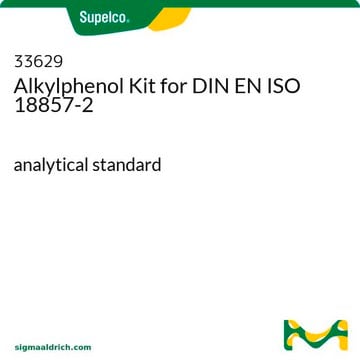442858
4-tert-Octylphenol
analytical standard
Synonyme(s) :
4-(1,1,3,3-tétraméthylbutyl)phénol
About This Item
Produits recommandés
Qualité
analytical standard
Niveau de qualité
CofA (certificat d'analyse)
current certificate can be downloaded
Conditionnement
ampule of 500 mg
Technique(s)
HPLC: suitable
gas chromatography (GC): suitable
Point d'ébullition
175 °C/30 mmHg (lit.)
Pf
79-82 °C (lit.)
Application(s)
environmental
Format
neat
Température de stockage
2-30°C
Chaîne SMILES
CC(C)(C)CC(C)(C)c1ccc(O)cc1
InChI
1S/C14H22O/c1-13(2,3)10-14(4,5)11-6-8-12(15)9-7-11/h6-9,15H,10H2,1-5H3
Clé InChI
ISAVYTVYFVQUDY-UHFFFAOYSA-N
Informations sur le gène
mouse ... Esr1(13982)
Vous recherchez des produits similaires ? Visite Guide de comparaison des produits
Catégories apparentées
Application
Produit(s) apparenté(s)
Mention d'avertissement
Danger
Mentions de danger
Conseils de prudence
Classification des risques
Aquatic Acute 1 - Aquatic Chronic 1 - Eye Dam. 1 - Skin Irrit. 2
Code de la classe de stockage
11 - Combustible Solids
Classe de danger pour l'eau (WGK)
WGK 3
Point d'éclair (°F)
296.6 °F
Point d'éclair (°C)
147 °C
Choose from one of the most recent versions:
Déjà en possession de ce produit ?
Retrouvez la documentation relative aux produits que vous avez récemment achetés dans la Bibliothèque de documents.
Les clients ont également consulté
Notre équipe de scientifiques dispose d'une expérience dans tous les secteurs de la recherche, notamment en sciences de la vie, science des matériaux, synthèse chimique, chromatographie, analyse et dans de nombreux autres domaines..
Contacter notre Service technique















